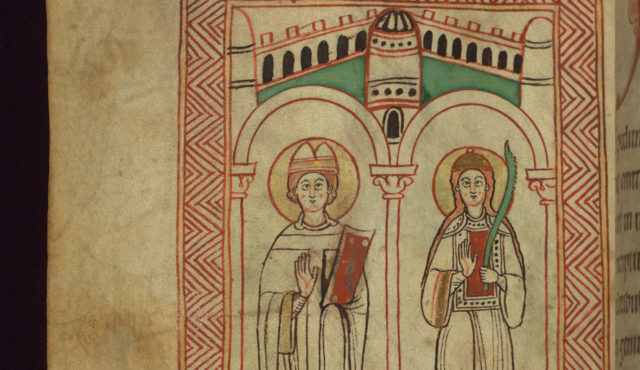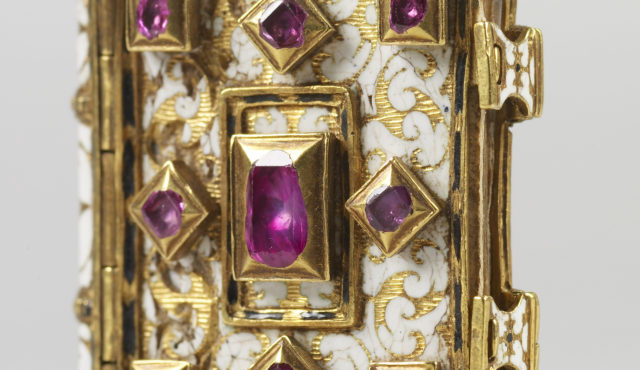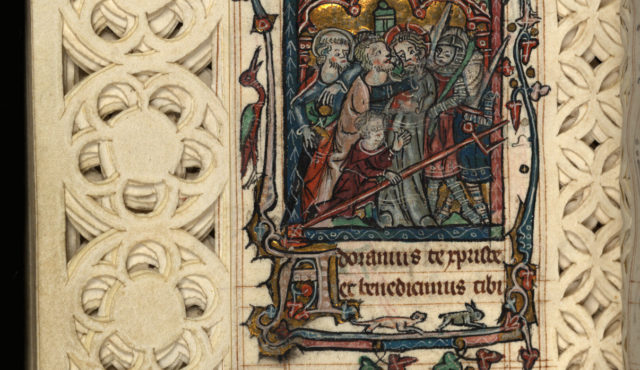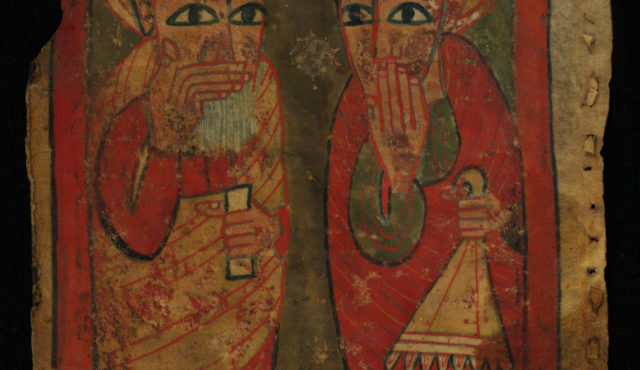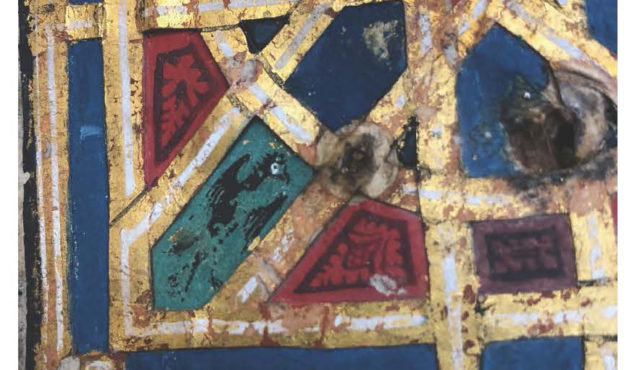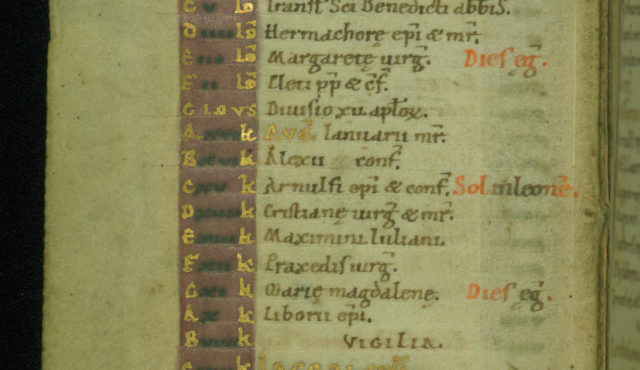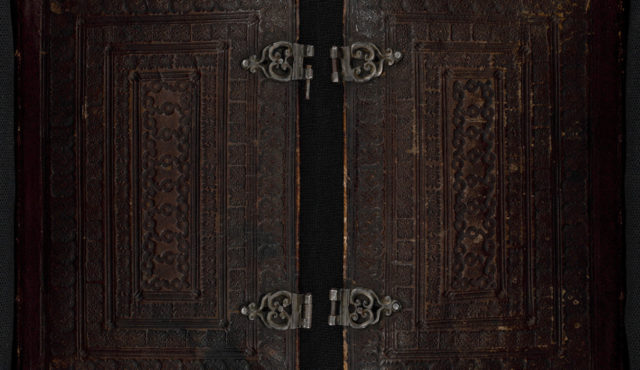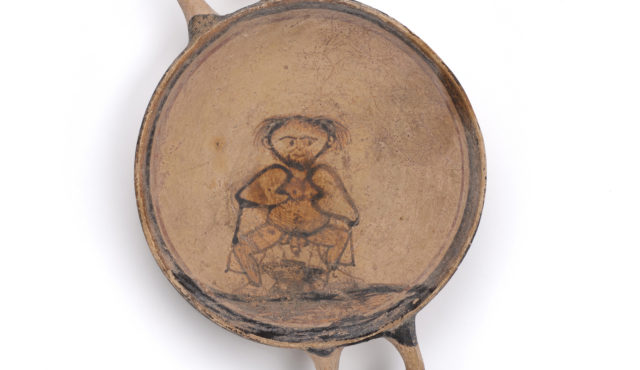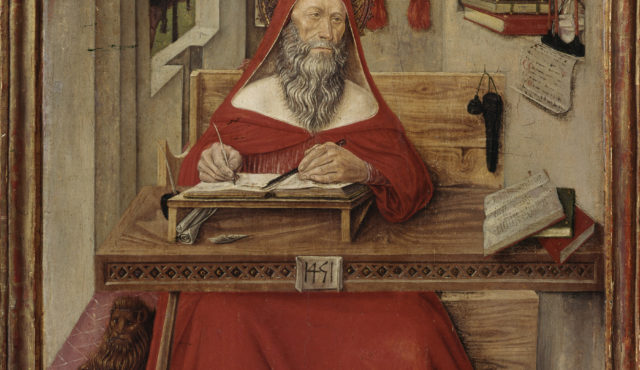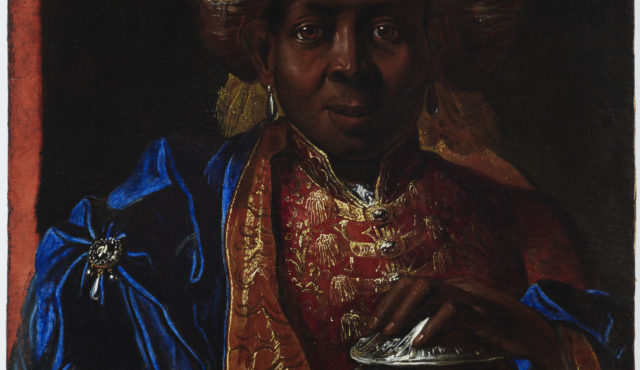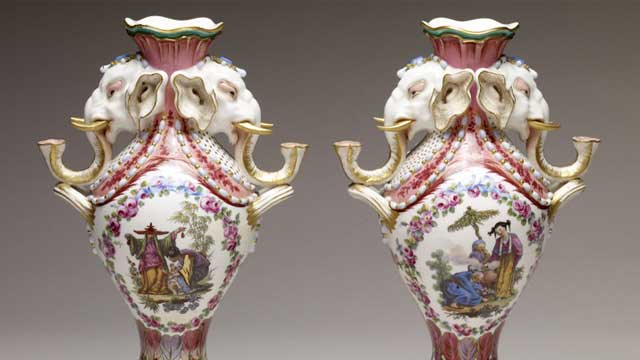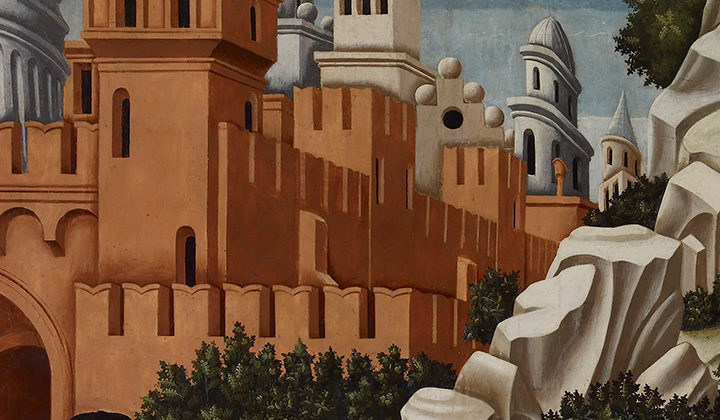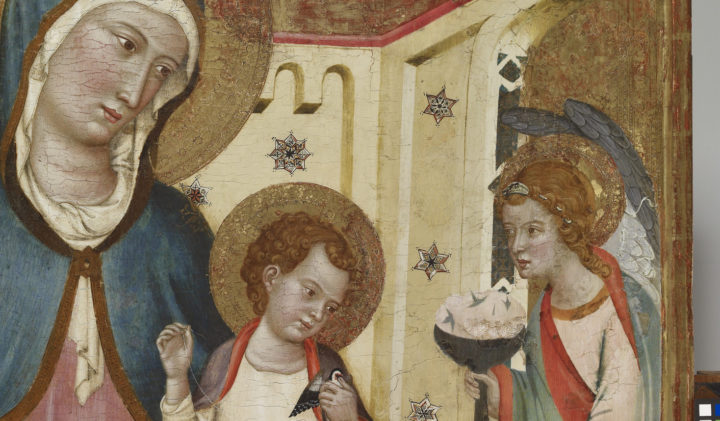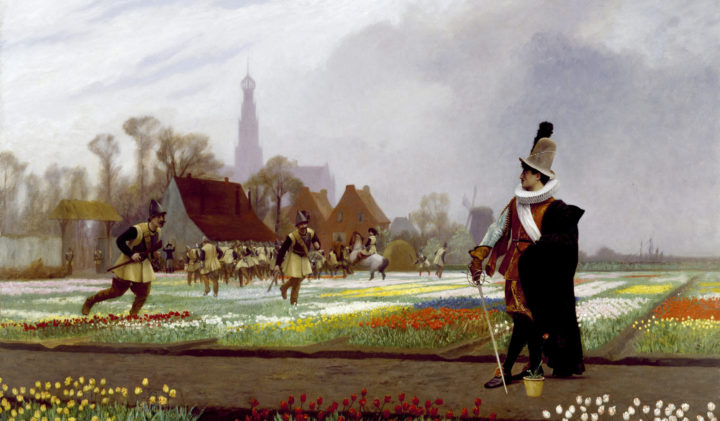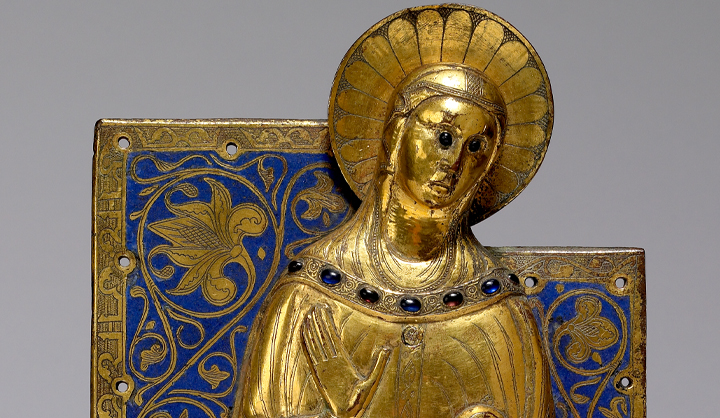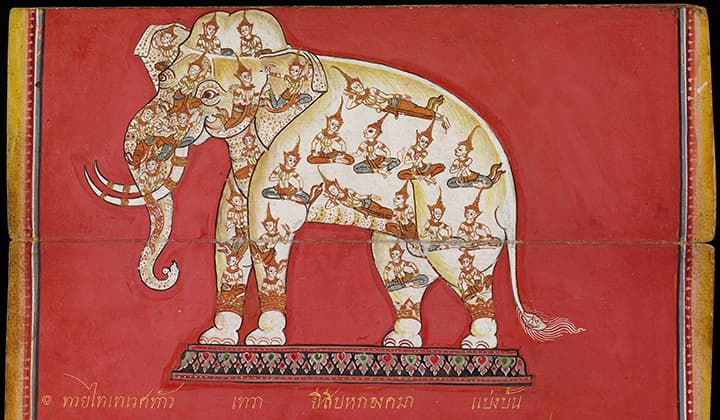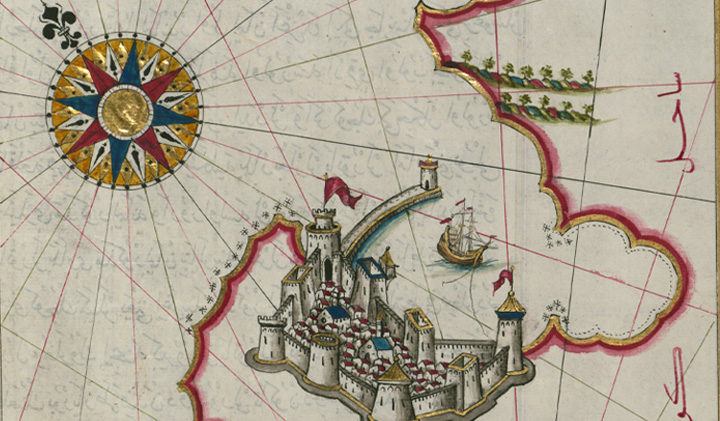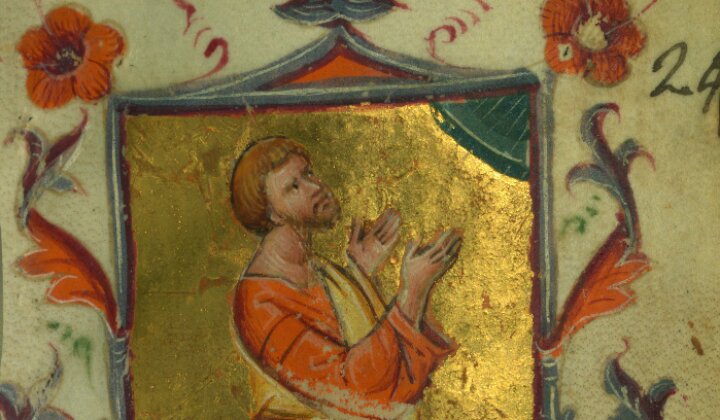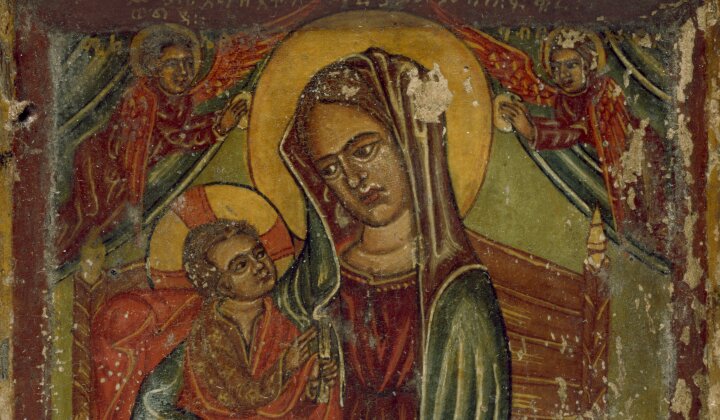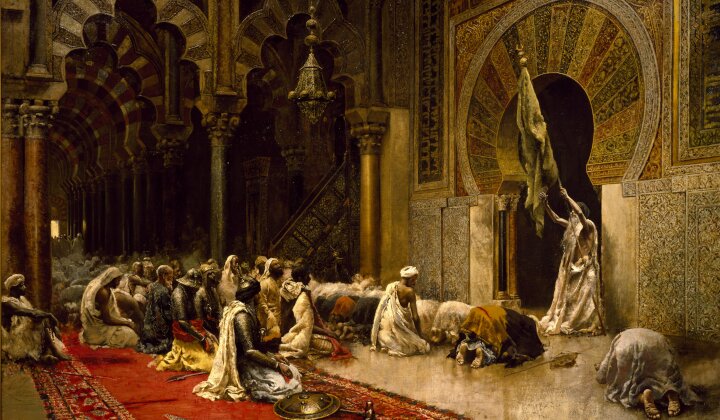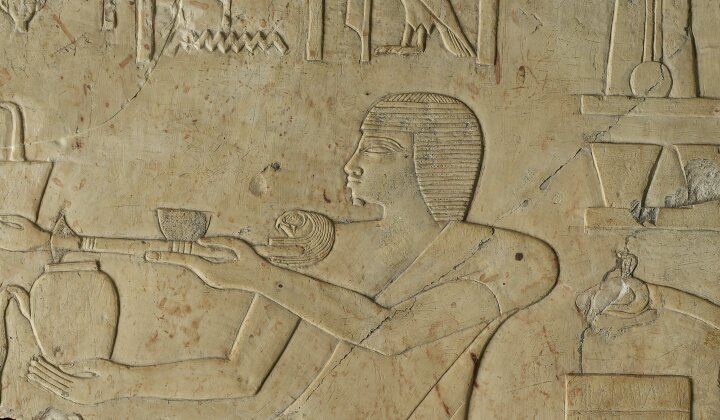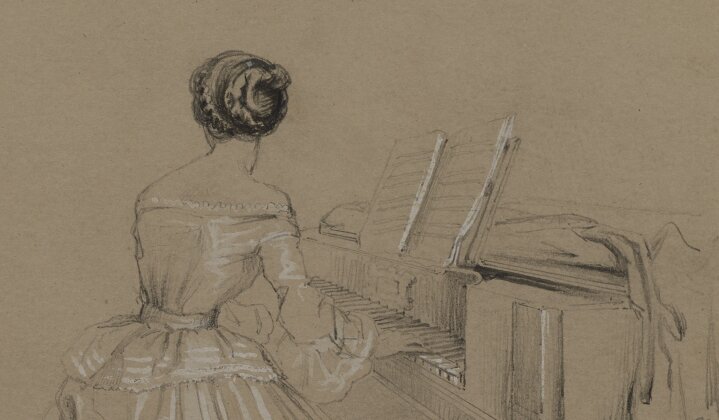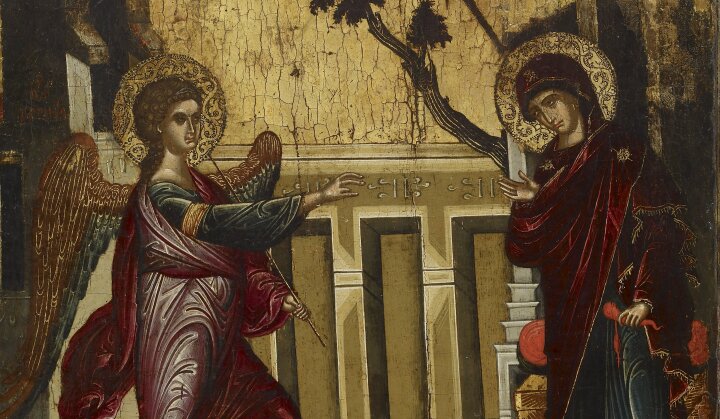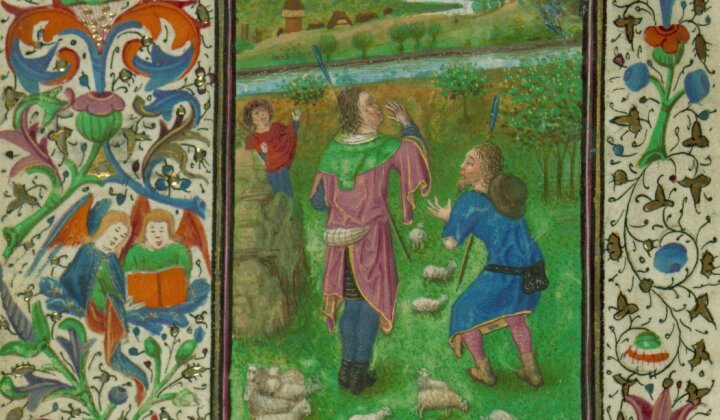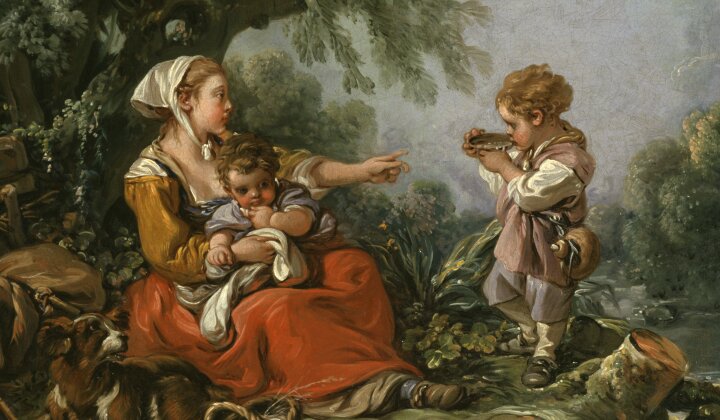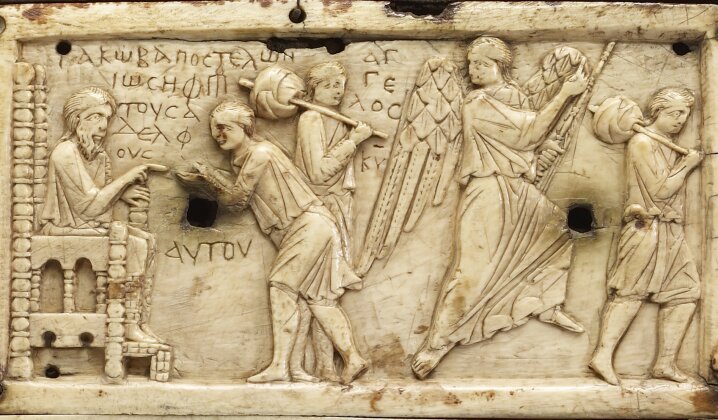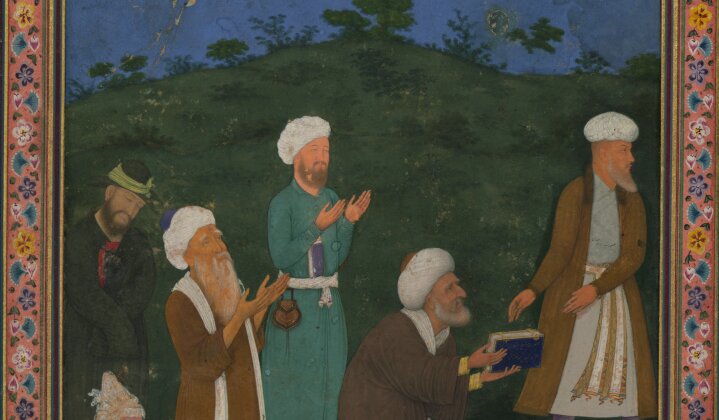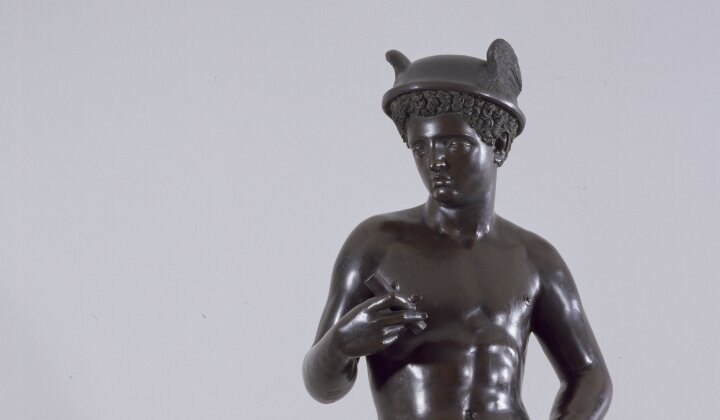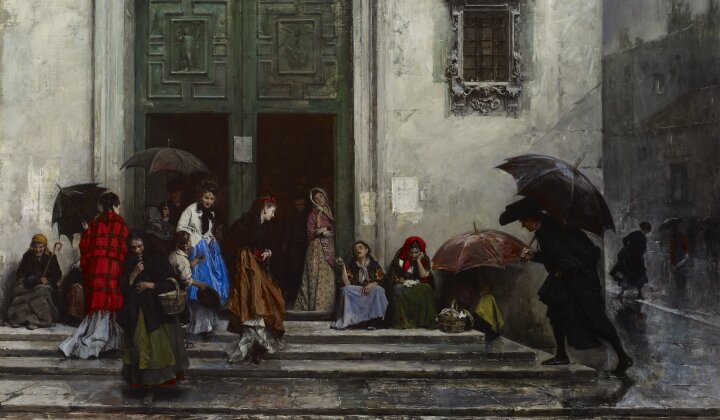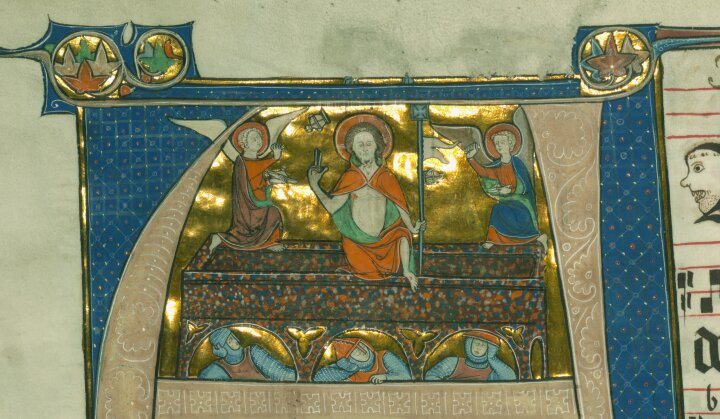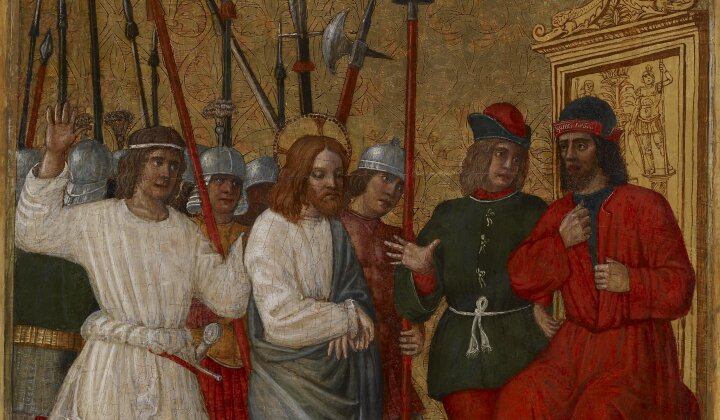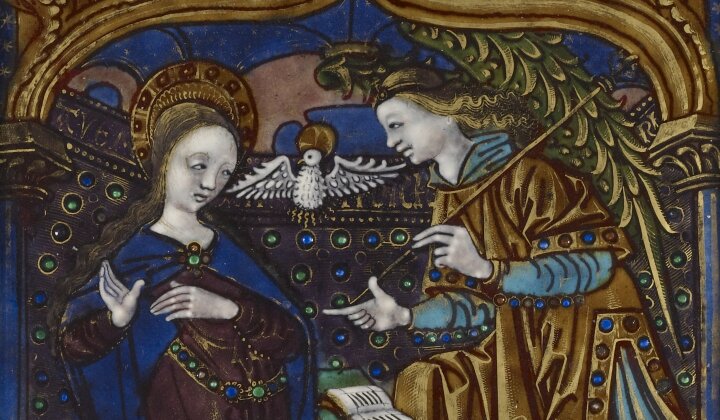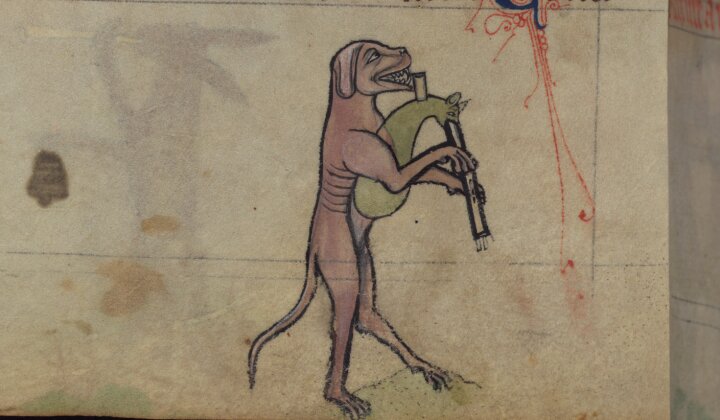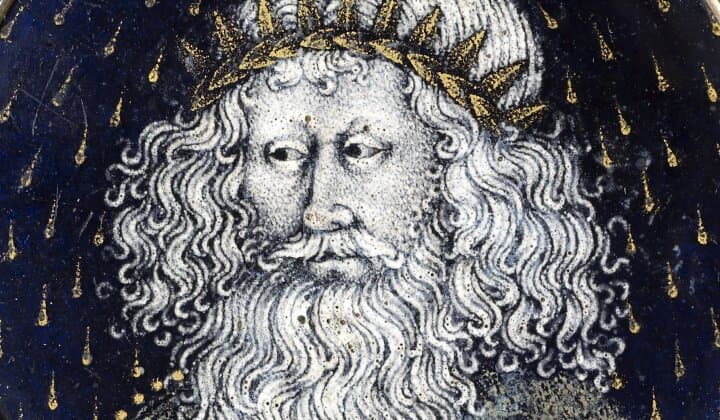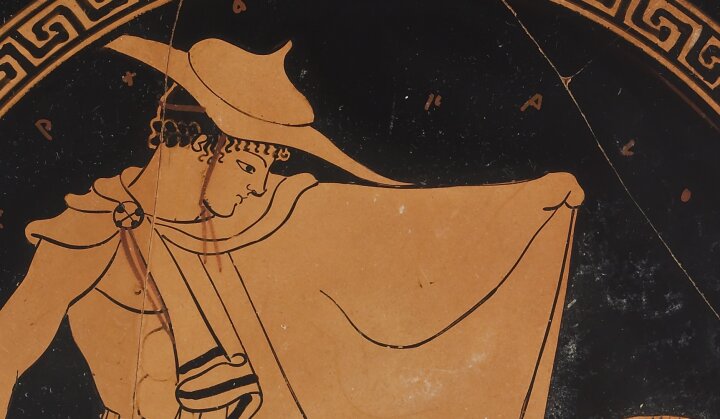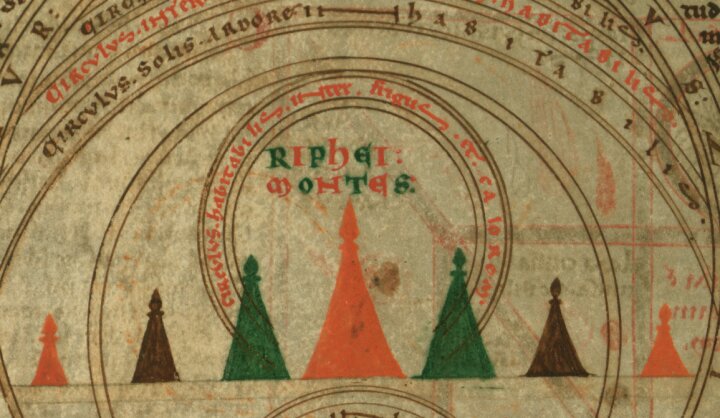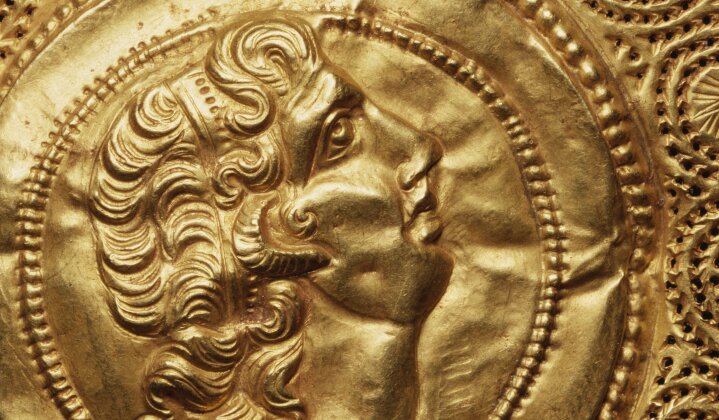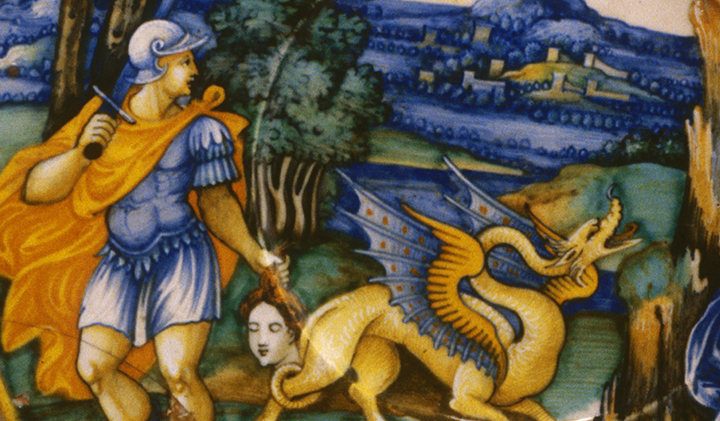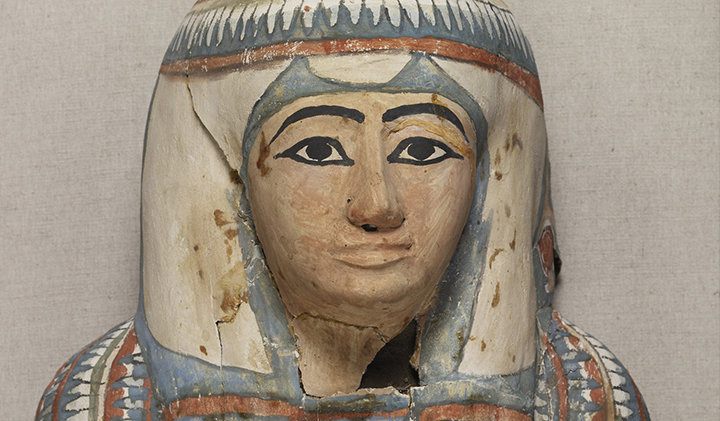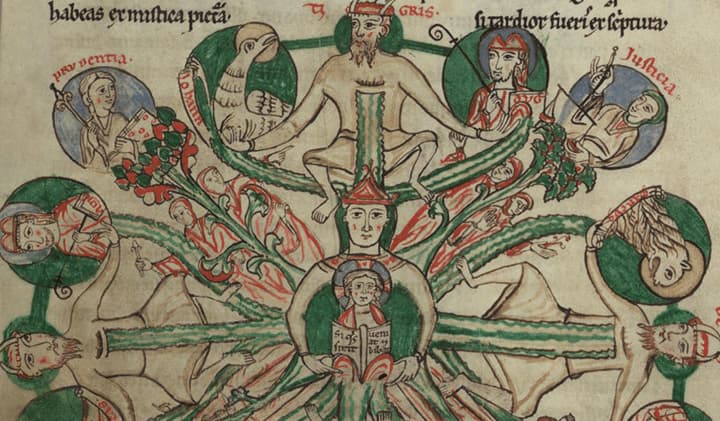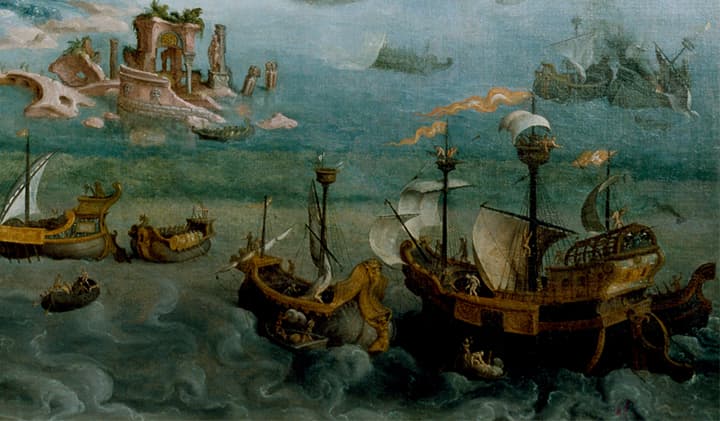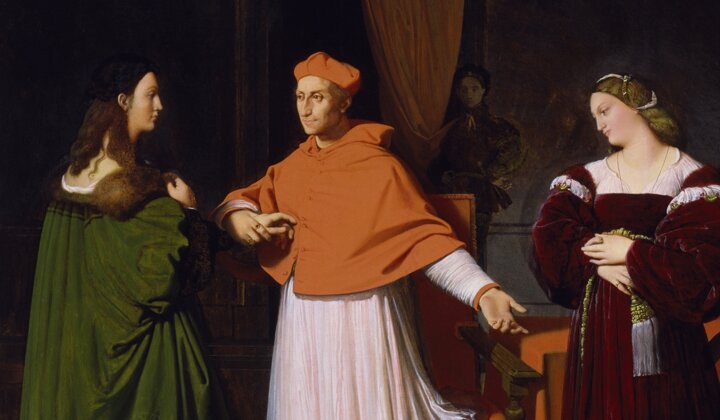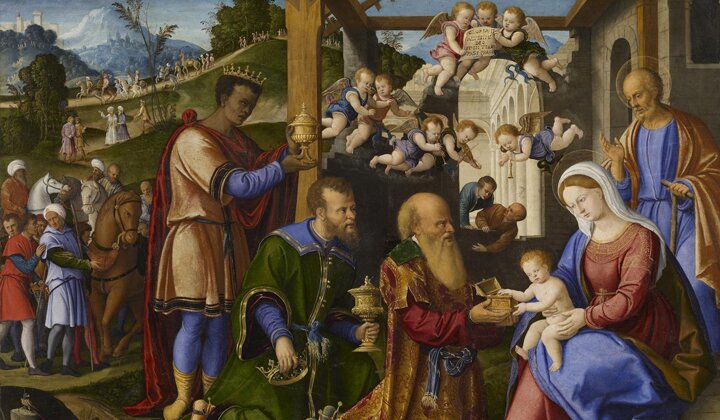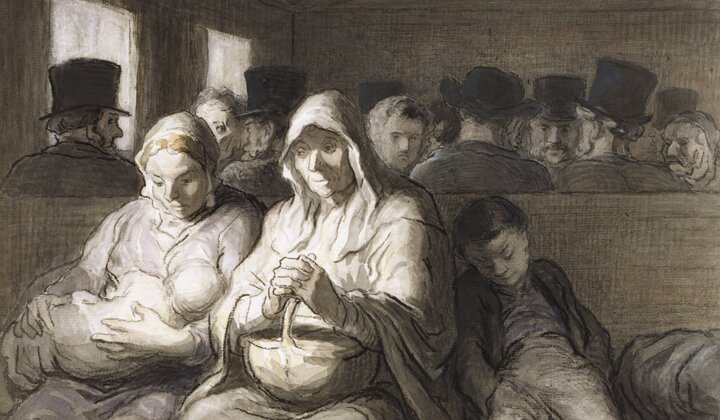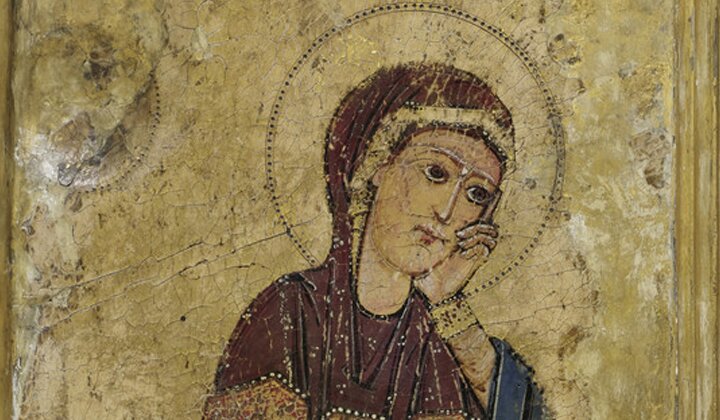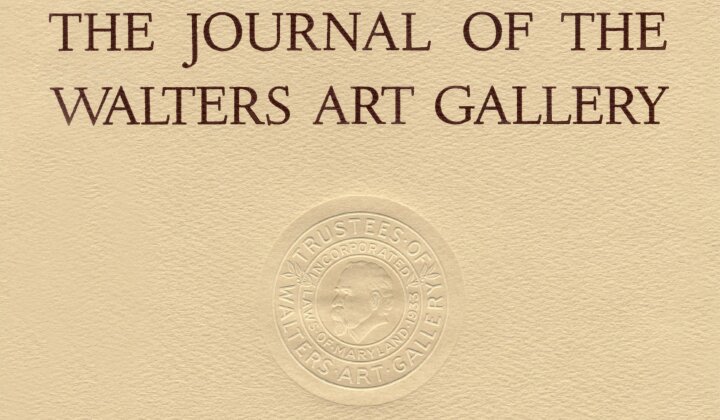A persistent myth in the history of the book is that between Antiquity and the Middle Ages the roll gave way to the codex. This idea is often encountered in the prepositional formula, “from roll to codex,” as ubiquitous as the phrase “from manuscript to print.”[1] Almost as common, “the triumph of the codex” is frequently expressed in narratives that correlate Christianity’s advent and spread with the codex’s dissemination. Assimilating the supersessionist belief in Christianity’s conquest over Judaism as God’s favored religion, the cliché is not a documentary account of the progress of the book through time. On the contrary, it distills in word a notion popularized in pictorial art that identified Christians as figures of the present with codices in their hands and Jews as relics of the past, holding scrolls.[2] R. W. McCutcheon has pointed to the place of this idea in the discipline of book history in a powerful passage worth quoting at length because of how well it encapsulates the biological model that gave it its legitimacy in modernity
In scholarship on the history of “book” over the longue durée, four seminal events typically define the stages of development of this artifact. These events are (1) the invention of alphabetic writing, (2) the shift from scroll to codex and the supposed rise of silent reading in Christian monastic culture, (3) the invention of the printing press and the increased dissemination of uniform information and the enlargement of public knowledge, and (4) the ongoing shift to digital media in our own age with the possibility of larger and more complex information storage within a hypertextual environment. We might say that alphabetic writing was the first sea creature to crawl onto shore and breathe air, while the scroll was the hirsute knuckle-dragging prelude to the more hygienic print codex, with the digital text becoming the final culmination of these physical developments and advancements—the apotheosis of the book into a noncorporeal yet omnipresent form.[3]
As McCutcheon goes on to discuss, in this evolutionary model lies the pernicious fallacy of cognitive evolution, the belief that as technologies “advance” so too does human thought. Faith in this fallacy underwrote the colonizing drive to “civilize” those cultures whose different communicative and textual technologies were seen as evidence of inferiority by those to whom alphabetic writing and codices had come exclusively to exemplify the idea of the book and intellectual superiority.[4]
If no longer yoked explicitly to colonial imperatives, the myth is tenacious because it seems so easily confirmed by daily experience. Visit any library and scan the shelves. Codices for miles. As others have pointed out, however, if we expand our field of vision to encompass the kind of textual and documentary culture beyond items we read for leisure, study, or reference, then the endurance of the scroll and roll in European and American milieus comes into view: think of diplomas, think of rolls of attorneys, enrolled government documents (inscribed in this format in the UK until 2017), and checks.[5] Their formats hark back to antiquity, whence their prestige, but less recognized is that the roll has persisted into modernity and today in mundane use, from punch cards for player pianos and rolls of film to tape measures to the scrolling digital display of a webpage to proofs of purchase, as anyone who has watched a cash register spit out a winding tongue tallying their items can attest.[6] The drugstore chain CVS has become so notorious for its exorbitant expenditure of paper on receipts that it has spawned a meme.[7] If bankrolls are by now just Hollywood shorthand for illicit trade, the form of paper currency that allows such rolling has its origins in medieval promissory documents.[8] And while not, strictly speaking a scroll, the rotular design of the rolodex—on which the title of this essay puns—was the singular achievement that allowed it to become a metonym for one’s networking prowess before the advent of computerized contact lists and cell phones.
An efflorescence of scholarship devoted to scrolls and rolls in medieval Europe has offered welcome pushback to the supersessionist model of book history. Whether for performance, prayer, legal and financial record-keeping, commemoration of the dead, liturgical celebration, medical and meteorological practice, the relation of history, or dynastic assertion, the roll persevered as a used and useful support for texts and images throughout the Middle Ages.[9] One of the prime examples of the roll’s enduring vibrancy is Peter of Poitiers’s Compendium historiae in genealogia Christi, a synopsis of Biblical history organized diagrammatically as a genealogy of Christ in the center, flanked by lines tracking judges and prophets, as well as various Old Testament dynasties and Roman emperors. The work survives in both roll and codex form in over 160 manuscript copies produced from shortly after its composition in the late twelfth century to the fifteenth century.[10] Scholarly consensus is that Peter originally designed his text for schoolroom presentation on a roll, which was later adapted to the codex format as a scholastic reference aid. This theory is entirely logical. And yet it is complicated by the surviving corpus of manuscripts, among which some of the earliest—including the subject of this essay—are codices.[11] Likewise, the theory mimics on a microcosmic scale the prepositional paradigm “from roll to codex” and can possibly be traced back to an eighteenth-century misunderstanding about the origins of the Compendium along these lines, a misunderstanding I address below. The purpose of this essay is not to disprove this theory. Rather, this essay is an experiment in thinking around the prepositional paradigm through Peter of Poitiers’s Compendium, as represented Walters Art Museum, Baltimore, acc. no. W.796.[12] What I will propose is that the text itself and its diagrammatic disposition were originally devised for both roll and codex, leading me to coin a neologism—the rollodex—that makes space for such ambidextrous works in manuscript culture. Even if I cannot prove this to have been the case (I cannot), the value of this thought experiment lies in the challenge it poses to a persistent paradigm in the history of the book, itself a genealogical narrative.
Roll or Codex?
Peter of Poitiers’s Compendium historiae in genealogia Christi was once described by the theologian N. Iung as “short, dry, and full of chronological errors, it is of little value.”[13] But contrary to Iung’s assessment, the work—measured by the number of witnesses, not to mention the other genealogical works it inspired—appears to have been highly valued from the moment of its composition to several centuries later. Peter of Poitiers (ca.1130–1205) taught theology at the University of Paris, and while the earliest surviving copy of the Compendium dates to the early thirteenth century, it is believed that he originally composed it in the 1170s or 1180s.[14] According to Peter himself, in a prologue I will discuss in greater detail below, the work was devised specifically to assist in the mental storage and recollection of Biblical history, a mnemonic or pedagogical aid that shows Iung’s dismissive assessment to have overlooked or missed entirely the point of the work. Several decades ago, Gabrielle Spiegel was among the first line of medieval historians to take such value judgments to task, and pointed to the genealogical character of much medieval history as exemplary of its status as “perceptual grids.”[15] By this phrase, Spiegel was referring to structures governing the kinds of human experiences historians deemed worthy of recounting, and determining how they saw those experiences meaningful for the relation of narratives about the past. In the years since, scholars have focused on both diagrammatic representation of history as well as manuscripts featuring genealogical material.[16] More recently, art historians, Andrea Worm chief among them, as well as scholars in other fields have attended more closely to the particularities of Peter of Poitiers’s Compendium in its manuscript form, not simply as (textual) history arranged diagrammatically but also as manifold and diverse demonstrations of the diagrammatic potentials of historical narration, responsive to the format in which it is copied.[17] My essay contributes to this body of analysis by focusing not on the diagram as a two-dimensional image but rather on the diagram’s intended inscription on different kinds of three-dimensional objects, each with its own affordances.
In the spirit of monopolizing such affordances, I want to take advantage of the digital format of the Journal of the Walters Art Museum itself and stage a brief experiment with the reader’s participation. The experiment asks only that you do the following: take a few moments and follow the narrative of Christ’s descent through this codex, produced in the early thirteenth century (fig. 1).
Peter of Poitiers (English, ca. 1130–1204), Compendium historiae in genealogia Christi (Historical Genealogy of Christ), early thirteenth century, ink and pigments on heavy, cream-colored parchment, W: 24.5 cm x H: 34.4 cm. The Walters Art Museum, Baltimore, museum purchase, 1981, acc. no. W.796
Now follow the same through this roll, British Library, London, acc. no. Add MS 60628/1, created in the middle of the thirteenth century (fig. 2).
Peter of Poitiers (English, ca. 1130‒1205), Compendium historiae in genealogia Christi (Historical Genealogy of Christ), ca. 1250–1260,
parchment with pigment, L: 506.5 x W: 28.5 cm. The British Library, London, acc. no. Add MS 60628/1
While numerous aspects of these manuscripts are obscured by their representation on a screen—their size and scale relative to one another arguably the most significant—and the physical actions of using them is brought into greater alignment as well, enough of their peculiarities linger to convey a sense of the different practices of beholding and reading that they allow. Counterintuitively, the Compendium in the Walters’ codex is not easy to read as a narrative. The first folio opens simply enough, presenting to the reader a brief prologue, beneath which stand Adam and Eve enframed within two arches and separated from one another by a thin column. But from this point forward, genealogy and history take a small diversion that branches out into increasing complexity on the page itself and as we turn the pages. Here, on this first page, the descendants of Adam and Eve track both a single path down the central axis of the page (the track that will eventually lead to Christ), while other descendants shoot off into spokes that squeeze the historical texts into blank spaces at times out of sync with the historical figures they describe. And as we move both down the page in step with the forward march of time, we must pause to to skim across its width to learn the stories of characters whose lives are not necessarily contemporary, but whose faces appear in near proximity. Keeping in mind the relationship between figures is made more complicated when we turn from fol. 1r to fol. 1v, where the central line of figures, beginning with Tare [Terah] appears on a blue-and-red axis that it not continuous with the simple outline of the central axis on the recto. Toggling between vertical and horizontal axes, the sequential and contemporary, and leaping from paragraphs that are often syntactically and circumstantially unrelated to those which precede and succeed them, produces in me a kind of readerly vertigo and directional indecision that discourages continuous reading.
The same text in the British Library roll (Add MS 60628/1) is likewise challenging to absorb, but differently so. One might think of scrolls and rolls as ideal for linear and sequential assimilation of material (and they often are), but the composition of this roll thwarts continuous reading beyond tiny increments of either image or text. To take just the first membrane, the beholder is first confronted with a complex diagram of Christ in Majesty within a mandorla, flanked by two angels on either side, each within a roundel interrupted by its intersection with the border around Christ. This already complex collection of figures and lines emerges from a seven-branched candelabrum, the stem of which continues down the length of the roll until it merges with the top of a tree that bisects the frame around the next figural scene.[18] Here, within an attenuated quatrefoil, Adam and Eve flank a thin trunk with sinuous leafy volutes extending from its sides and summit and entwined by the body of the serpent, its human head facing Eve as she embarks on her first bite. Two columns of text fill in the space on either side of these sequential images, each segmented by rubrics and paraphs of alternating red and blue, which allegorize the candelabrum, offer Peter’s own prologue to the work, and initiate an account of Biblical history. The process of assimilating the visual and textual information provided, not to mention identifying meaning in the form in which they are expressed, requires genuine effort and concentration from the reader-viewer. Both the codex and the roll posed unique challenges to the navigation of this work, and I believe it is because when Peter of Poitiers set out to combine narrative history and genealogy, he put to himself a task that was both difficult and valuable in its difficulty. Indeed, the many and varied surviving manuscripts of the Compendium show producers working out how best to handle and often struggling with this task, leaving behind them a legacy of over 160 copies of the Compendium that vary not only between formats but also from copy to copy.
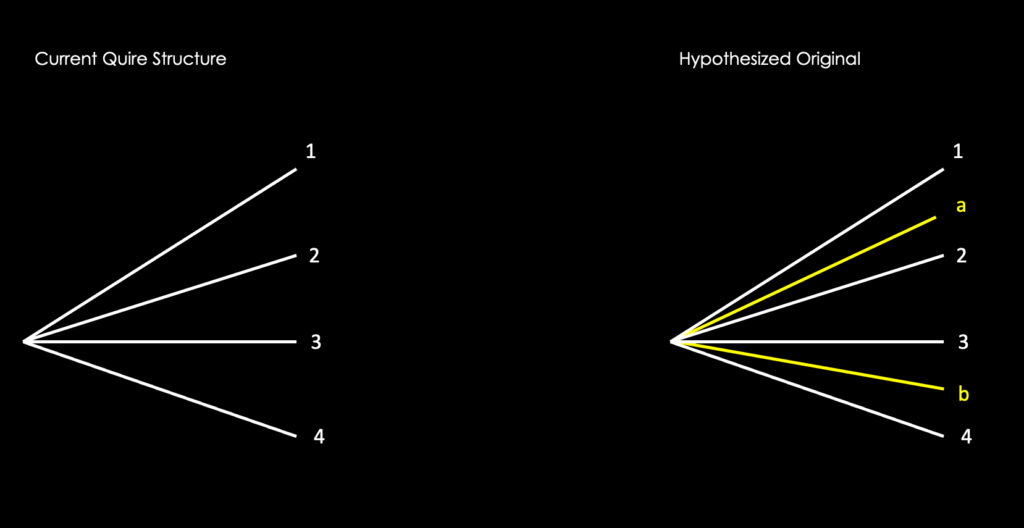
Diagram showing the current quire structure and the hypothesized original quire structure of Peter of Poitiers, Compendium historiae in genealogia Christi, acc. no. W.796
Reading and beholding the Walters’ copy of the Genealogia exemplifies the exertions required of its audience to process its visual and textual content. It appears to have been produced not long after 1200, and probably in England. Currently it stands as an independent quire of four, rebound in the nineteenth century. However, it is missing a bifolium (fig. 3): the text is discontinuous, and a close copy in the Bibliothèque nationale de France (acc. no. Latin 14435, fols. 136r–142r) allows us to infer with a reasonable degree of certitude the missing portions.[19] This copy, also from ca. 1200, is integral to a larger codex, containing a number of other works also by Peter of Poitiers. As Andrea Worm has pointed out, codex versions of the Genealogia were almost unanimously (if not universally) designed for inclusion in larger volumes, suggesting its intended use as a reference text, almost like a biographical appendix.[20] It seems reasonable to suppose that the Walters copy was likewise once part of a larger volume. When it lost a bifolium is impossible to ascertain but from the soiling on the current first and final folios, it seems that this section of the text traveled independently for some time, or at least long enough to collect dirt and moisture. It also bears a crease down the middle of its length, best seen on folio 4v, suggesting it was folded perhaps for ease of toting around or storage. Finally, a medieval reader, from the thirteenth or fourteenth century judging from the script, added the names of the kings of Britain, according to Geoffrey of Monmouth, adjacent to the Biblical figures who were apparently their contemporaries, starting with Ebraucus, founder of York (fig. 4). This leads me to believe that the now-missing bifolium was indeed present at this early period because the name of Brutus, founder of Britain, would have appeared on it (near the Biblical figures of Phares and Esron, who would have been on the missing bifolium), and it would seem unusual to start this list of kings with Ebraucus. In this respect, the manuscript may be an early witness to the proto-national appropriations of Christological genealogy that, as Joan Holladay has recently discussed, shortly thereafter became royal genealogies and universal chronicles.[21] While it is impossible to say when the Walters’ Genealogia was unmoored from its original codicological context, I think I can say with some confidence that shortly after its origins, it was being adapted to suit interests and concerns beyond the mnemonic and pedagogical ones forecast by its author.
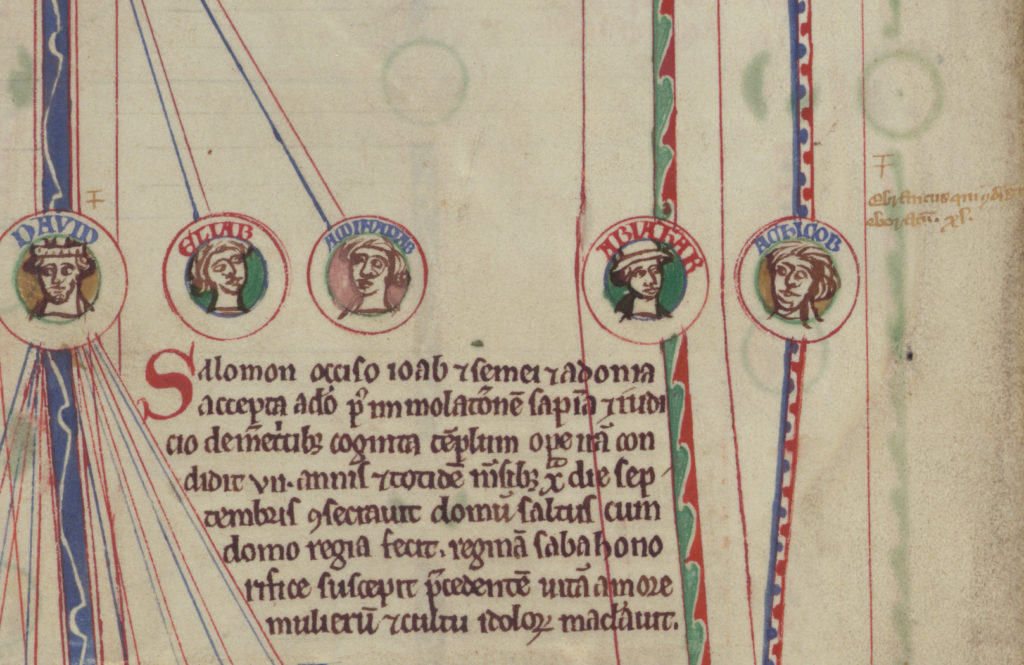
Rollodex
These interests and concerns are expressed in a prologue to the Genealogia, which is the main textual attestation to its origins and conception. In it the author recounts
Considering how voluminous Holy Scripture is, and the difficulties encountered by scholars who study it, especially those who have neglected its historical foundation, and also those who for a lack of books seek a remedy for their limited expertise, wishing to retain in the memory the historical narratives as if it were in a little sack, I have attempted to reduce into a single, small work the sequence of the holy fathers, from whom through the priestly and royal tribe Christ took his origin, along with their works. It is recommended for those put off by the scale of the subject, so that they might keep it by the eyes in their memory, and will be of use to all readers. I have undertaken this difficult task with the utmost assiduity and vigilance, and with brevity according to the given form. Therefore I have taken care to skip over nothing of the historical truth, but beginning with Adam, I have proceeded through the patriarchs, judges, kings, prophets and priests of their time ending with Christ.[22]
This preface is effectively an intentio auctoris, which shares the general outlines of many academic prologues of the period, albeit in less scholastic form.[23] In it Peter discloses the pedagogical reasons for embarking on this project: to produce a mnemonic aid for those who, for lack of ability to assimilate the vast information of the Bible or for lack of money to purchase their own books—in whatever form, whether codex or roll—cannot recall the narratives of scriptural history. Scholars interested in both the history and use of diagrams in the Middle Ages, as well as those who concentrate on the art of memory, have long remarked upon this passage as a significant attestation to the rising interest during the twelfth century in the production of aides-mémoires to assist with the rapidly expanding body of knowledge and commentary that were being generated at the universities.[24]
What bears equal attention are the terms that Peter uses to describe what he has composed: namely, a little or minor work (opusculum). Not a book, not a volume, not the product of writing (common phrases in prefatory matter at the time), but rather, a short work (for which we might also read, a short text).[25] The same word, albeit not in the diminutive, he uses to refer to the deeds (operibus) carried out by Biblical figures. When Peter does refer to the physical object in which a text is inscribed, he writes the word “books” (librorum), in reference to their lack by students who cannot afford them (an age-old problem in university education). Peter’s choice of opusculum here is significant not because the term “opus” was uncommon in scholastic prologues (it wasn’t); rather, it is significant because it was written precisely during a time and in a place (twelfth-century Paris) of heightened attentiveness to the idea of skilled work over raw material, when invocations of and revisions to the Ovidian verse materiam superabat opus (the workmanship surpassed the material) appear prominently on and in textual descriptions about shaped matter itself.[26] What is unusual about Peter’s invocation of the term is its appearance quite apart from any physical matter at all, in a milieu in which “there was no question of detaching opus from material.”[27] In other words, unlike other authors whose prefaces speak of both the opus and the materia, i.e., the book (materia), which is the result of workmanship (opus), and unlike inscriptions on and textual descriptions of objects that revive the Ovidian topos, Peter uses the diminutive to equate the little text (opusculum) with its result, leaving the reader entirely uncertain as to its final material shape.[28] Perhaps it is the mnemonic function of the text itself that led Peter to avoid specifying the physical format in which his text should be encountered.[29]
And so despite the specificity of the purpose to which Peter wanted his opusculum to be put, details about its actual appearance and use are absent from his prologue. For this, scholars have turned to an obituary of Peter, written by Alberic of Trois Fontaines (died 1251), according to whom
[In 1205] Master Peter of Poitiers, Chancellor of Paris died…who, looking out for poor students, devised trees sketched on skins (in pellibus depingere) that displayed the histories of the Old Testament.[30]
We cannot know how truthful this obituary is, but what intrigues me about it is its reference to skins, (pellibus). Peter’s own preface moves from the practical contingencies of objects, the very materiality of which makes them inaccessible and therefore useless (books that students cannot afford to own), to the utility of an immaterial work stored in a mental sack. In contrast, the commemoration of his eulogist is concerned with the material substrate of the information’s conveyance (skins). Although it tempts scrutiny, I want to leave aside the metaphorical valence of skin in the context of Christ’s genealogy and incarnation and focus instead on its literal valence. Why “skin” and not “parchment” (pergamenum; membrana)? Alberic’s obit has led most scholars to assert that the Genealogia Christi was displayed upon a classroom wall, but the wording does not allow for anything conclusive. While the biographer does not mention vertical exhibition, his reference to animal hides or skins (as opposed to parchment) and the use of the objects for consultation has suggested the communal nature of them, and hence their vertical exhibition. But it is an unusual suggestion, that skins would be hung on classroom walls. It seems the individual who gave rise to this supposition is the antiquarian Abbé Jean Lebeuf who wrote in 1743, “Since books cost a lot of money to write and print was not in use as it is now, there were stretched skins placed on the walls of classrooms, on one of which was represented in tree form the histories and genealogies of the Old Testament…”[31] I know of no twelfth- or thirteenth-century evidence for this practice beyond the display of mappamundi in monastic and, later, domestic, contexts.[32] Certainly, my inability to find evidence for the practice does not rule it out; however, I am disinclined to take the eighteenth-century antiquarian’s word for it. It seems the obit is not describing display conditions but rather Peter’s exploitation of an affordable or intermediary support as a technology for thinking and for arranging ideas that might find their ultimate presentation in different, less provisional, and more costly, formats. Technically, “skin” in this context likely refers to the material in its preparatory phase, that is, after it had been removed from the herse (stretching frame), and before it had been cut or smoothed or folded or ruled, each a process that incurred a further charge.[33]
Less technically, two sources afford greater insight into the significance of the term pellis in the context of textual composition in the twelfth and thirteenth centuries. The first comes from the conclusion to letter 102 of Peter of Blois’s Epistles, in which the author writes
I had shortened this brief exhortation of mine, written down with a pruned pen, but love, if it does not know the end (indeed, charity never ebbs) was scarcely able to reach the end of writing. Thus brevity turns out vast, a small note [or draft or scrap or parchment offcut] grew into a skin (schedula crevit in pellem), and an epistle transformed into a book. Farewell.[34]
In a similar formulation, and deriving from a treatise that resembles Peter’s Genealogia in its contents, Girard of Auvergne’s (or Anvers) Abbreviatio historiae figuralis,[35] originally composed in 1272 for Pope Gregory X and revised for Abbot Yvo of Cluny, apologizes at its conclusion for its length in the following terms
Certainly, father, I had undertaken to write a short thing, but a short thing grew into a long thing. Indeed, an unrestrained pen has strayed into vastness owing to the material that surged up to be composed. A brief note [or draft or scrap or parchment offcut] grew into a skin (cedula crevit in pellem). A skin grew into skins, skins into a roll and a roll transformed into a book.[36]
Both passages are envoys that seem to derive from the same formula, a humility topos excusing excessive length.[37] In the first, schedula crevit in pellem is part of a series of three parallel clauses in which the first term connotes concision and the second verbosity: brevity…vast; small note [or draft or scrap or parchment offcut]…skin; epistle…book. However, in the second instance, the same formula, cedula crevit in pellem,” is part of an escalating construction in which the skin is one degree lengthier or less finished than a brief note [or draft or scrap or parchment offcut], a degree briefer or less finished than numerous skins, and briefer or less finished still than a roll and a book. Generally, the term schedula is taken to mean a brief note, but it is possible that it could refer to offcuts, the scraps of parchment that were the byproduct of cutting rectangles from the stretched animal skin, and which were used in the production of cheap manuscripts, students’ personal notes, and drafts. Often, as Erik Kwakkel has pointed out, it can be difficult to discern whether the material object or genre of composition is meant in a given occurrence of the term.[38] And while the word “skin” is used differently in these two instances, they share an intermediary position (whether as the middle clause of three parallel constructions, or as a middle item in an ascending list) between spontaneous, perhaps short, jottings on the byproducts of the parchment-making process and a completed textual work.
What might this tell us about either Peter’s own labor or how the author of his obituary framed that labor? If we juxtapose the two words pellis and opusculum, I think what we see is the intrinsically or even deliberately experimental and economical nature of the Compendium and its identity as a labile text designed for an array of codicological embodiments. In other words, no matter how it was originally sketched and written out, Peter appears to have built into his “small work” the expectation that it would be adjusted to a variety of forms, for whichever purpose it might serve.
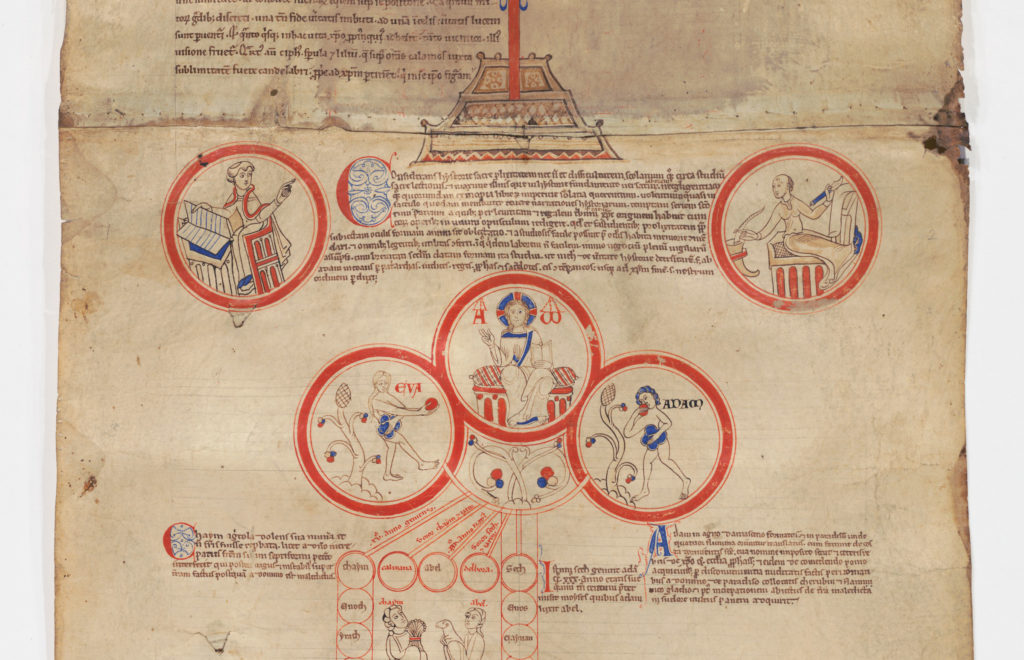
Detail showing the Prologue flanked by a cleric with a codex and a layman with a scroll and writing implements above Christ enthroned holding an open book and flanked by medallions enclosing the figures of Adam and Eve, Peter of Poitiers, Compendium historiae in genealogia Christi, Northern France, ca. 1200–1250. Harvard University, Houghton Library, Cambridge, MA, acc. no. MS Typ 216
The intermedial nature is suggested on another roll, an early copy of the Compendium now in the Houghton Library, Cambridge, MA (acc. no. MS Typ 216), which, in apparently reversing the prepositional paradigm “from roll to codex” reaffirms the prejudices inherent in it.[39] At the top of the manuscript’s second membrane, flanking the text of Peter’s prologue, are two figures enclosed in roundels, who represent the intellectual and physical labor that goes into producing the kind of object we are examining (fig. 5): on the left a tonsured cleric sits before a desk with an open codex, his right hand gripping the upper edge of its recto side. The blue ruling on the open pages indicates that this is a finished book, which the cleric is consulting.[40] However, in this paused moment, he is not reading the text; rather, his head is turned away from the book as he glances backward over his shoulder and with his left hand points in the direction of both the prologue and another figure in a roundel to the right. That figure is a balding layman, also seated—albeit on a less elaborate chair—before a desk. On the desk is a long vertical strip of parchment, which slinks over its edge and above which hovers the layman’s left hand, holding a knife. Like his counterpart, he concentrates not on the writing surface before him but rather glances over his shoulder back in the direction of the prologue’s text and the cleric to the left. His right hand grasps a pen poised just above an inkhorn affixed to the medallion’s inner frame. This configuration modifies a common iconography in which a learned theologian dictates instructions to a scribe or illuminator, perhaps best known from a copy of the Bible Moralisée (Morgan Library, New York, acc. no. MS M.240) from roughly twenty-five to fifty years later. In both cases, we are made to see both the intellectual and physical labor that produces a highly learned engagement with Scripture, deeply dependent for its effectiveness on visual form.
But what distinguishes the Houghton Compendium’s representation from others is the discrepancy between the medium being consulted (a codex) and that being produced (a roll). This is a discrepancy that, on the one hand, presents a reversal of the speech scrolls that represent the word of God descending from on high to the Evangelists who transcribe this sacred dictation on to codices or bifolia; but on the other hand, it reaffirms the supremacy of the codex or the myth of its advancement over the roll in that this ensemble correlates bibliographical formats with Peter’s promise of simplification. After all, Christ sits enthroned in his own medallion below, clasping an open codex in one hand and offering a benediction with the other.[41]
So, I am deliberately posing the following not as a conclusion but as a question: what if the very effectiveness of Peter of Poitiers’s experiment lies in its identity as a text that was extracted from codices but which was in itself conceived of—planned—as something that might find presentation in either a roll or a codex? What if, in other words, the Genealogia is effective because it is not streamlined for a particular platform, and its very difficulty demands a mental labor that results in engagement and assimilation? It is common today to prize “optimization,” to believe that media is effective when it renders itself nearly invisible as a conveyance because of how well adapted its contents are to its form. But perhaps the opposite was the case for Peter of Poitiers, or at least for his purposes here. Conceiving of the Walters copy of the Compendium within this framework—that is, not as the result of a transition from roll to codex but rather as a realization of the little work in codex that is coextensive with rotular versions—dislodges it from a narrative of technological progressivism, opening it to analyses that appreciate codicological diversity as a condition of manuscript culture. It may be that the pivotal nature of Christ in the minds of medieval Christians suggested to Peter of Poitiers the suitability of his experiment in both the formats of roll and codex.
My thanks to the participants in the workshops held at the Walters Art Museum and Johns Hopkins University for their feedback on the paper from which this article grew. I am also grateful to Aden Kumler for sharing her insights while discussing parts of this essay with me.
[1] See, for example, Anthony Grafton, “From Roll to Codex: A Christian Initiative,” in Piet van Boxel and Sabine Arndt, eds., Crossing Borders: Hebrew Manuscripts as a Meeting-Place of Cultures(Oxford: Bodleian Library, 2009), 15–20; Michelle P. Brown, “The Triumph of the Codex: The Manuscript Book before 1100,” in Simon Eliot and Jonathan Rose, eds., A Companion to the History of the Book (Oxford: Wiley-Blackwell, 2007), 179–93.
[2] Michael Camille, “Visual Signs of the Sacred Page: Books in the Bible moralisée,” Word & Image 5 (1989): 111–30. Camille quotes Bishop Durandus, who wrote in the late thirteenth century, “the Patriarchs and Prophets are painted with scrolls as if to denote this imperfect knowledge. But since the Apostles were instructed perfectly by Christ, they can be shown with books, by which is suitably depicted their perfect knowledge.” I have taken this text from a more recent edition and translation by Timothy M. Thibodeau, The Rationale Divinorum Officiorum of William Durand of Mende: A New Translation of the Prologue and Book One (New York: Columbia University Press, 2010), 7.
[3] R. W. McCutcheon, “Silent Reading in Antiquity and the Future History of the Book,” Book History 18 (2015): 1–32, at 18.
[4] Michael Clanchy, From Memory to Written Record: England, 1066–1307, 3rd ed. (Oxford: Wiley-Blackwell, 2013), 7–11; Walter Mignolo, The Darker Side of the Renaissance: Literacy, Territoriality, and Colonization (Ann Arbor: University of Michigan Press, 1995), esp. 29–68.
[5] Thomas Forrest Kelly, The Role of the Scroll: An Illustrated Introduction to Scrolls in the Middle Ages (New York: Norton, 2019), 41–45.
[6] While acknowledging that “format” has a specific meaning in print (size of paper + how it is folded, whether folio, quarto, etc.), there is no word to refer to the different shapes of manuscript books, and so I follow Pamela Robinson in giving “format” this meaning. Pamela Robinson, “The Format of Books: Books, Booklets, and Rolls,” in Nigel Morgan and Rodney M. Thompson, eds., The Cambridge History of the Book in Britain, 1100–1400(Cambridge: Cambridge University Press, 2008), 39–54.
[7] See https://knowyourmeme.com/memes/cvs-receipts.
[8] Olivier Guyotjeanin, “The Format of Documents,” in Frank T. Coulson and Robert G. Babcock, eds., The Oxford Handbook of Latin Paleography (Oxford: Oxford University Press, 2020),644–50, at 647.
[9] A select list of of publications on rolls in English from roughly the last decade includes the following. On prayer rolls and arma christi rolls, see Sonja Drimmer, “Beyond Private Matter: A Prayer Roll for Queen Margaret of Anjou,” Gesta 53, no. 1 (2014): 95–120; and Andrea Denny-Brown and Lisa H Cooper, eds. The Arma Christi in Medieval and Early Modern Material Culture: With a Critical Edition of “O Vernicle” (Burlington, VT: Ashgate, 2014). On exultet rolls, see Nino Zchomelidse, “Descending Word and Resurrecting Christ: Moving Images in Illuminated Liturgical Scrolls of Southern Italy,” in Nino Zchomelidse and Giovanni Freni, eds., Meaning in Motion. The Semantics of Movement in Medieval Art (Princeton: Princeton University Press, 2011), 3–34. On chronicle rolls, see Lisa Fagin Davis, La Chronique Anonyme Universelle Jusqu’a La Mort de Charles VII (Turnhout: Brepols, 2010). On mortuary rolls, see Stacy Boldrick, “Speculations on the Visibility and Display of a Mortuary Roll,” in Jack Hartnell, ed., Continuous Page: Scrolls and Scrolling from Papyrus to Hypertext (London: Courtauld Books, 2020), 101–21. Onmedical rolls, see Katherine Storm Hindley, “’Yf A Woman Travell Wyth Chylde Gyrdes Thys Mesure Abowte Hyr Wombe’: Reconsidering the English Birth Girdle Tradition,” in Hartnell, Continuous Page, 159–74. On rolls that record works in another medium, see Conrad Rudolph, “The Parabolic Discourse Window and the Canterbury Roll: Social Change and the Assertion of Elite Status at Canterbury Cathedral,” Oxford Art Journal 38 (2015): 1–19. And on royal genealogies, see Jaclyn Rajsic, History Unrolled in Late Medieval England: Negotiating the British and English Pasts in Royal Genealogies (Oxford: Oxford University Press, forthcoming). For an extensive bibliography on scholarship devoted to rolls, see https://medievalscrolls.com/bibliography.
[10] This count is taken from Laura Alidori, “Il Plut. 20.25 della Laurenziana. Appunti sull’iconografia dei manoscritti della Genealogia di Petrus Pictaviensis,” Rivista di storia della miniatura 6–7 (2002): 157–70, at 166–68.
[11] See Alidori, “Il Plut. 20.25 della Laurenziana,” Appendix.
[12] I first used the phrase “prepositional paradigm” to describe histories of the book that rely on an expectation of evolution, in which book forms proceed neatly from one kind of textual technology to another, in Sonja Drimmer, “Introduction: The Manuscript Copy and the Printed Original in the Digital Present,” in Sonja Drimmer, ed., Manual Impressions: Visualizing Print in Manuscript, c. 1450–1850 [special issue of Digital Philology, 9, no. 2] (2020): 93–119.
[13] “Pierre de Poitiers,” in Alfred Vacant, Eugene Mangenot, and Emile Amann, eds., Dictionnaire de théologie catholique: contenant l’exposé des doctrines de la théologie catholique, leurs preuves et leur histoire, Vol. 12.2 (Paris: Letouzey et Ané, 1908), 2038–40, at 2040.
[14] See Philip S. Moore, The Works of Peter of Poitiers, Master in Theology and Chancellor of Paris (1193–1205) (Notre Dame: The University of Notre Dame, 1936), 97–117.
[15] Gabrielle M. Spiegel, “Genealogy: Form and Function in Medieval Historical Narrative,” History and Theory 22, no. 1 (1983): 43–53, at 46.
[16] The literature in these areas has grown enormously over the last two decades. For a recent volume devoted to diagrammatic representation, including a comprehensive bibliography, see Marcia Kupfer, Adam S. Cohen, and J. H. Chajes, eds., The Visualization of Knowledge in Medieval and Early Modern Europe (Turnhout: Brepols, 2020). And most recently on genealogical manuscripts or chronicles featuring genealogical diagrams, see Laura Cleaver, Illuminated History Books in the Anglo-Norman World, 1066–1272(Oxford: Oxford University Press, 2018), 156–96; and chapters in Joan Holladay, Genealogy and the Politics of Representation in the High and Late Middle Ages (Cambridge: Cambridge University Press, 2019).
[17] Important studies of the Compendium include William H. Monroe, “A Roll-Manuscript of Peter of Poitiers’ Compendium,” The Bulletin of the Cleveland Museum of Art 65 (1978): 92‒107; Hans-Eberhard Hilpert, “Geistliche Bildung und Laienbildung. Zur Überlieferung der Schulschrift Compendium historiae in genealogia Christi (Compendium veteris testamenti) des Petrus von Poitiers (gest. 1205) in England,” Journal of Medieval History 2 (1985): 315–31; William H. Monroe, “13th- and Early 14th-Century Illustrated Genealogical Manuscripts in Roll and Codex: Peter of Poitiers’ Compendium, Universal Histories and Chronicles of the Kings of England” (PhD diss., Courtauld Institute of Art, London, 1989); Stella Panayotova, “Peter of Poitiers’s Compendium in genealogia Christi: The Early English Copies,” in Richard Gameson and Henrietta Leyser, eds., Belief and Culture in the Middle Ages: Studies Presented to Henry Mayr-Harting (Oxford: Oxford University Press, 2001), 327‒41; Andrea Worm, “‘Ista est Jerusalem’. Intertextuality and Visual Exegesis in Peter of Poitiers’ Compendium historiae in genealogia Christi and Werner Rolevinck’s Fasciculus temporum,” in Lucy Donkin Hanna Vorholt, ed., Imagining Jerusalem in the Medieval West (Oxford: Oxford University Press, 2012), 23‒162; Andrea Worm, “Visualizing the Order of History: Hugh of Saint Victor’s Chronicon and Peter of Poitiers’ Compendium historiae,” in John McNeill and Richard Plant, eds., Romanesque and the Past. Retrospection in the Art and Architecture of Romanesque Europe (Leeds: British Archaeological Association, 2013), 243‒64; Andrea Worm, “England’s Place within Salvation History: An Extended Version of Peter of Poitiers’ Compendium historiae in London, British Library, Cotton MS Faustina B VII31,” in Laura Cleaver and Andrea Worm, eds., Writing History in the Anglo-Norman World: Manuscripts, Makers and Readers, c.1066–c.1250 (Woodbridge: Boydell and Brewer and York Medieval Press: 2018), 29‒52; and Andrea Worm, “Medium und Materialität: Petrus von Poitiers’ Compendium historiae in genealogia Christi in Rolle und Codex,” in Patrizia Carmassi und Gia Toussaint, eds., Codex und Material(Wiesbaden: Harrasowitz [Wolfenbütteler Mittelalter-Studien 34], 2018), 39–63 and 314.
[18] On the seven-branched candelabrum in Peter’s Genealogia, see Jeffrey Hamburger, Diagramming Devotion: Berthold of Nuremberg’s Transformation of Hrabanus Maurus’s Poems in Praise of the Cross (Chicago: University of Chicago Press, 2020), 17–20; and Walter Cahn, “The Allegorical Menorah,” in Jeffrey F. Hamburger and Anne S. Korteweg, eds., Tributes in Honor of James H. Marrow: Studies in Painting and Manuscript Illumination of the Late Middle Ages and Northern Renaissance (Turnhout: Brepols, 2006), 117–26.
[19] A microfilm of the manuscript has been digitized and can be accessed at https://gallica.bnf.fr/ark:/12148/btv1b9066760h.
[20] Worm, “Medium und Materialität,” 47–48.
[21] Holladay, Genealogy and the Politics of Representation.
[22] Translation with minor edits from Worm, “Ista est Ierusalem,” 127–28: Considerans scripture sacre prolixitatem, necnon et difficultatem scolarium quoque circa studium sacre lectionis, maxime illius que in historie fondamento versatur negligentiam, quorumdam quoque ex inopia librorum imperitie sue solatium querentium, volentibus, quasi in sacculo quodam memoriter tenere narrationes hystoriarum, temptavi seriem sanctorum patrum a quibus per leviticam et regalem tribum Christus originem habuit, cum eorum operibus, in unum opusculum redigere. Quod et fastidientibus prolixitatem propter subiectam oculis habita memorie commendari et omnibus legentibus utilitatem conferre. In quo quidem non facilem laborem immo negotium plenum vigiliarum assumpsi cum brevitati secundum datam formam. Ita studui ut nichil de veritate historiae detruncarum sed ab Adam inchohans per patriarchas, judices, reges, prophetas, et sacerdotes eis contemporaneos usque ad Christum, finem nostrum perduxi. See Moore, The Works of Peter of Poitiers, 99.
[23] On a more scholastic prologue by Peter, see Alastair Minnis, The Medieval Theory of Authorship: Scholastic Literary Attitudes in the Later Middle Ages, 2nd ed. (Philadelphia: University of Pennsylvania Press, 1988), 63–66.
[24] Mary Carruthers, The Book of Memory: A Study of Memory in Medieval Culture (New York: Cambridge University Press, 1990), 250–51.
[25] For example, in the Prologue to his Sentences, Peter Lombard uses opus to refer to his own labor and hic volumen (“this volume” or “this book”), and brevi volumen divided into quatuor libros (“four books,” meaning four main parts or textual divisions) to describe its product. For a broader discussion of academic prologues, see Minnis, Medieval Theory, 9–72
[26] See Peter Cornelius Claussen, “Materia und Opus: Mittelalterliche Kunst auf der Goldwaage,” in Victoria von Flemming and Sebastian Schütze, eds., Ars naturam adiuvans: Festschrift für Matthias Winner zum 11. Marz 1996(Mainz: Von Zabern, 1996), 40‒49 and Aden Kumler, “Materials, Materia, ‘Materiality,’” in Conrad Rudolph, ed., A Companion to Medieval Art: Romanesque and Gothic in Northern Europe (Hoboken, NJ: Wiley Blackwell, 2019), 95–117.
[27] Claussen, “Materia und Opus,” 44.
[28] Enrico Castelnuovo, “Materiam superabat opus,” in Enrico Castelnuovo, Ori e argenti dei santi: il tesoro del duomo di Trento (Trento: Temi Editrice, 1991), 11–20; Martin Büchsel, “Materialpracht und die Kunst für ‘Litterati’: Suger gegen Bernhardvon Clairvaux,” in Martin Büchsel and Rebecca Müller, eds., Intellektualisierung und Mystifizierung mittelalterlicher Kunst (Berlin: Mann, 2010), 155–82; Beate Fricke, “Artifex and Opifex: The Medieval Artist,” in Rudolph, A Companion to Medieval Art, 45–69.
[29] On medieval distinctions between the book and the text, see Carruthers, The Book of Memory, 8ff.
[30] My translation of text taken from Georg Heinrich Pertz, ed., Monumenta Germaniae Historica 23 (Hannover: Hahnsche Buchhandlung, 1874), 886: Obiit Magister Petrus Pictaviensis … qui pauperibus clericis consulens excogitavit arbores historiarum Veteris et Novis Testamenti in pellibus depingere, et de vitiis et virtutibus similiter compendiose disponere. Typically, depingere in this excerpt is translated as “painted,” but I have rendered it “sketched” here.
[31] Jean Lebeuf, Dissertations sur l’histoire ecclésiastique et civile de Paris (Paris, 1739–1743), II, 133. This was then cited in Moore, The Works of Peter of Poitiers, 108; reiterated in Beryl Smalley, The Study of the Bible in the Middle Ages (Oxford: Blackwell, 1983), 25; and then has been repeated in the literature since.
[32] Carlos Miranda García cites, in connection with the Genealogia, Stephen Langton (d.1228) as attesting to the hanging of a painted parchment on a classroom wall in Paris, but this appears to be a misreading of the sources he cites, such as Carruthers, The Book of Memory, 250; and Smalley, The Study of the Bible, 214; see Carlos Miranda García, “Mnemónica y Pedagogía en el Compendium historiae in genealogia Christi de Pedro de Poitiers / Mnemonics and Pedagogy in the Compendium historiae in genealogia Christi by Peter of Poitiers,” in Maria Algàs and Mónica Miró, eds., Genealogia Christi (Barcelona: M. Moleiro, 2000), 32. Large mappamundi from the thirteenth and early fourteenth centuries, like the Hereford and Ebstorf maps, appear to have been devised for communal contemplation, and there is a reference to a mappamundi on parchment “in the hall” of a fifteenth-century inventory written on an endleaf in Huntington Library, San Marino, CA, acc. no. HM 744, endleaf 1r. There is little doubt that medieval lecturers incorporated large or monumental works of visual art into their expositions—Hugh of St. Victor’s Mystic Ark from before 1141 the best-known example. But works such as this appear to have been static displays, such as wall painting.
[33] See Michael Gullick, “From Parchmenter to Scribe: Some Observations on the Manufacture and Preparation of Medieval Parchment Based upon a Review of the Literary Evidence,” in Peter Rück, ed., Pergament: Geschichte, Struktur, Restaurierung, Herstellung, Vol. 12 (Sigmaringen: Jan Thorbecke, 1991), 145–57.
[34] My translation of text taken from Jacques-Paul Migne, ed., Patrologia Latina, Vol. 207 (1855): Hanc ex hortatiunculam meam stylo recisiore exarare decreveram, sed amor, qui finem nescit (caritas enim nunquam excidit) vix finem potuit invenire scribendi. Evasit itaque brevitas in immensum, schedula crevit in pellem, et epistola transivit in librum. Vale.
[35] On this treatise, see Leopold Delisle, “Le chroniqueur Girard d’Auvergne ou d’Anvers,” Journal des savants (1900): 232–42 and 285–94; and Gert Melville, “Geschichte in graphischer Gestalt. Beobachtungen zu einer spätmittelalterlichen Darstellungsweise,” in Hans Patze, ed., Geschichtsschreibung und Geschichtsbewusstsein im späten Mittelalter (Sigmaringen: Thorbecke, 1987), 57–154, at 85–88.
[36] My translation of text taken from Vatican Library, acc. no. Vat.lat.3839, fol. 34v: Breve quidem, pater, scribere inceperam, sed breve crevit in longum. Exuberante enim dictandi materia, stilus licentius a debito evagatus est in immensum. Cedula crevit in pellem. Pellis in Pelles. Pelles in Rotulum et Rotulus transivit in Librum. To my knowledge this text has not been edited.
[37] A search of the Colophons de manuscrits occidentaux des origines au XVIe siècle (Fribourg: Editions universitaires, 1965–1982) did not, however, turn up this formula.
[38] Erik Kwakkel, “Discarded Parchment as Writing Support in English Manuscript Culture,” English Manuscript Studies 1100–1700 17 (2012): 238–61; and Erik Kwakkel, “Classics on Scraps: Classical Manuscripts Made from Parchment Waste,” in Manuscripts of the Latin Classics (Leiden: Leiden University Press, 2015), 107–29. Both essays also discuss the use of schedula for note-taking in the medieval classroom as well as for drafts. One text that he cites in particular, from Ælfric Batta’s Colloquy 3, represents a dispute between two students: “At the end of the argument various writing supports are listed which the lazy student apparently did not use very frequently. ‘You don’t want to sing willingly’, the one student complains, ‘or write on your tablet or on a vellum scrap or on a parchment [sheet] or in a quire’ (‘nec scribere in tabula, nec in scedula, nec in ullo pergameno nec in nulla quaternione’);” see Kwakkel, “Discarded Parchment,” 243. Significant here is the ascending formality of the writing supports listed. See also Charles Burnett, “Give him the White Cow: Notes and Note-taking in the Universities in the Twelfth and Thirteenth Centuries,” History of Universities 14 (1995–6): 1–30, esp. 16–20.
[39] On this manuscript, see Lisa Fagin Davis, “Peter of Poitiers, Compendium historiae in genealogia Christi,” in Jeffrey F. Hamburger, William P. Stoneman, Anne-Marie Eze, Lisa Fagin Davis, and Nancy Netzer, eds., Beyond Words: Illuminated Manuscripts in Boston Collections (Boston: McMullen Museum, 2016), 121–22.
[40] While illuminators between the twelfth and fourteenth centuries commonly used a few lines of script or pseudo-script to suggest that the represented book is a completed one or one in the process of being written when it accompanies a person with writing implements in hand, illuminators also used ruling as shorthand for a completed book. See, for example, the historiated initial of Gregory holding open a book with ruled pages in Walters Art Museum, Baltimore, acc. no. W.148, fol. 24v (Germany, ca. 1320); the representation of Hugh of St. Victor lecturing to his students from a ruled but not inscribed book in Bodleian Library, Oxford, acc. no. MS Laud Misc. 409, fol. 3v (St. Albans, ca. 1190–1200); St. Benedict presenting a ruled but not inscribed book to three monks in British Library, London, acc. no. Add MS 16979, fol. 21v (Nîmes, 1129); Christ in Majesty holding an open book, which is ruled but not inscribed in British Library, London, acc. no. Lansdowne MS 383, fol. 14v (England, 1125–1150); and St. Benedict seated with an open book, faintly ruled but not inscribed in British Library, London, acc. no. Royal MS 20 D vi, fol. 161v (Paris, ca. 1225–1250).
[41] The codex here is blank, reflecting the perfection and all-encompassing nature of its contents, untainted by their need to be transcribed as text for legibility in the material world. See Camille, “Visual Signs of the Sacred Page,” 11.
